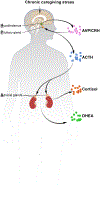The impact of caregiving for children with chronic conditions on the HPA axis: A scoping review
- PMID: 36773674
- PMCID: PMC10182255
- DOI: 10.1016/j.yfrne.2023.101062
The impact of caregiving for children with chronic conditions on the HPA axis: A scoping review
Abstract
Caregiving has been robustly linked to caregiver health through the dysregulation of the hypothalamic-pituitary-adrenal (HPA) axis in the context of caregiving for an adult with a chronic illness. However, little research examines the physiological impact of caregiving for a child with a chronic illness despite high burden and unique stressors. In this review, we explore the links of caregiving for a child with a congenital, chromosomal, or genetic disorder to the regulation or dysregulation of the HPA axis. A search was conducted in PubMed, Embase, and the Web of Science and 15 studies met inclusion criteria. Overall, there were inconsistent links of caregiving to HPA axis functioning, perhaps due to the heterogeneity across disease contexts, study designs, and biomarker measurement. Future research should standardize measurement and study designs, increase participant diversity, and examine moderators of the links of caregiving to the HPA axis.
Keywords: Caregiving; HPA axis; Pediatric illness; Stress.
Published by Elsevier Inc.
Conflict of interest statement
Declaration of Competing Interest The authors declare that they have no known competing financial interests or personal relationships that could have appeared to influence the work reported in this paper.
Figures
References
-
- Aldwin CM (2007) Stress, Coping, and Development: An Integrative Perspective (2nd ed.). Guilford Press.
-
- Allen AP, Curran EA, Duggan A, Cryan JF, Chorcoráin AN, Dinan TG, Molloy DW, Kearney PM, & Clarke G (2017). A systematic review of the psychobiological burden of informal caregiving for patients with Dementia: Focus on cognitive and biological markers of chronic stress. Neuroscience and Biobehavioral Reviews, 73, 123–164. 10.1016/j.neubiorev.2016.12.006 - DOI - PubMed
-
- Arksey H, & O’Malley L (2005) Scoping studies: Towards a methodological framework. International Journal of Social Research Methodology, 8(1), 19–32. 10.1080/1364557032000119616 - DOI
Publication types
MeSH terms
Grants and funding
LinkOut - more resources
Full Text Sources
Miscellaneous



